Track
In this guide, I’ll walk you through Sora’s functionalities with step-by-step examples. You’ll learn how to navigate the platform, use presets, and apply advanced tools like storyboarding, blending, and looping. By the end, you’ll have a solid grasp of Sora’s features.
If you want a theoretical overview, I recommend this blog on Sora AI. You can also check out our guide to using the Sora 2 API.
Getting Started With Sora
To access Sora, we need a ChatGPT subscription. However, as of this writing, Sora isn't available in every country yet—you can check here the countries where Sora is available.
To get started, we can access Sora from its dedicated website, https://sora.com/, or directly from ChatGPT by clicking the Sora button on the top left:
To create a video, simply describe it in the text prompt at the bottom of the screen.

Here’s the result:
Pricing and limits
Sora is included in the ChatGPT Plus and Pro subscriptions. Here’s the plan comparison:
Base options
Apart from the prompt, the base options available when generating a video are:
- Using an image or video to drive video generation
- Selecting a style preset
- Setting the aspect ratio: 16:9, 1:1, or 9:16
- Setting the resolution: 480p, 720p, or 1080p
- Setting the video duration: 5s, 10s, 15s, or 20s
- Select how many variations to generate: 1, 2, or 4
The last button, marked with a question mark (?), indicates how many credits will be used with the current settings when we hover it:
Navigating Sora’s UI
Here’s an overview of the Sora’s menu that you can find on the left side of the home page:
If you click on the Featured section, you’ll be able to see what other people created. These can be a great inspiration for your videos. To see how a video was generated, we can click on it and then hover or click on the prompt shown at the bottom of the video:
Since prompts are public, a great way to get started with Sora is by finding videos you like, checking the prompts used, and using them as a starting point for your own videos.
Once we generated a video, Sora offers us four useful tools to better control the output: re-cut, remix, blend, and loop.

Let’s start by exploring the remix feature.
Remix
The remix feature in Sora allows us to modify a video by describing what we want to be altered.
We can adjust the strength of the remix in three levels: “subtle”, “mild”, “strong”, or “custom”, depending on how significant the change is.
- Subtle: For minor adjustments, like removing a small object.
- Mild: For moderate changes, such as adding a few extra elements.
- Strong: For major transformations, like changing the entire look or structure of an object.
In the next example, we show a remix of a video created using the prompt:
“Far away aerial shot of a car driving along the countryside during golden hour with a picturesque village in the far background of the scene.”
After generating the initial video, I modified it using a mild remix asking to replace the car with a horse carriage and a strong remix asking to replace the village with a forest. Here’s a side-by-side edit of the three videos:
We can also remix videos created by others by clicking the remix button at the bottom of the video:
Let’s try to turn the cat into an elephant using a strong remix.

Here’s the result:
Depending on the remix level, the video might change more than we want. By changing the custom remix level, we can experiment with several levels to find the right amount.
Finally, since Sora allows us to upload our videos, we can also use the remix feature to make changes to existing videos. To upload a video, use the + button at the bottom of the text prompt:

Remix as an upscaler
I’ve seen some creators using the remix feature as an upscaler, that is, to increase the resolution or level of detail of an existing video.
To do this, we can upload the low-resolution video, ask Sora to remix it without prompting, and set the highest resolution available to our plan. Sora will output a similar video but with a higher resolution.
This is particularly useful when combined with other AI video generation tools.
Loop
The loop feature in Sora lets us create a smooth repetition of a specific segment within a video. Here's how it works:
1. Define the video section: First, we choose the part of the video we want to loop.
2. Adjusting loop handles: In the editor, we see two handles on the timeline: one to set the start of the loop and another for the end. These handles help us fine-tune exactly which frames of the video will form the loop.

3. Choose loop length: Depending on how similar the beginning and end frames of the looped section are, we might adjust the loop type to “short”, “normal”, or “long”. A “short” loop works well if the frames blend naturally, while “normal” or “long” options give Sora more time to connect the frames if they differ significantly.
4. Creating the loop: After setting the handles and choosing the loop length, Sora generates a looping segment, ensuring the transition between the end and start is smooth and appears continuous.
The loop feature is great for creating endless visual cycles, like waves crashing on a shore, that can enhance the aesthetic appeal and storytelling of our video projects.
The video below shows the result of trying to loop a video created using the prompt:
“A drone hyperlapse above a city at rush hour. ”
The video loops as the first and last frame match but we see that Sora had to create some artifacts to force the video to loop.
Some videos aren’t easy to loop. Videos with movement in a single direction tend to be looped simply by reversing the movement, which often isn’t what we want, like here:
The best videos to loop are abstract animations or videos of a movement that is naturally a cycle, like waves crashing on rocks. Here’s an example:
Re-cut
The re-cut feature allows us to regenerate part of a video. This feature is particularly useful for fixing errors or building longer scenes. It's effective for completing sequences when multiple actions are involved, as you can break down each action into separate prompts and re-cuts to achieve the desired result.
Consider the following video:
The end of the video is a bit strange when the giraffe turns around. We can use the re-cut feature to select the ending and ask Sora to generate just that part.
The thing we need to do is to cut the video and isolate the parts we don’t want. To cut a clip in half we can use the “S” key. By making several cuts, we can isolate the part of the video we don’t want:

In this case, we want to delete the last two cuts of the video when the giraffe starts turning away. Then we can add instructions on what to generate or leave it blank. In this case, we just want Sora to complete the video based on the first part so we can leave it blank and hit the “Create” button:

Here’s the side-by-side comparison between the original video and the re-cut:
Notice that the end now looks more natural. We can of course also cut from the middle, not just from the start or the end of a video.
The re-cut feature is quite useful because Sora often generates a video with parts that are good as well as some that are bad and unnatural. Using re-cut we can keep the good and regenerate the bad until we get something we like overall.
Blend
The blend feature in Sora allows us to combine two separate videos into one cohesive clip. This technique can result in creative and unexpected visual outcomes. Here’s a step-by-step guide on how it works.
1. Select videos to blend: First, we choose a video from our library that we want to use.
2. Access the blend editor: Once we've selected a video, we open the blend editor by clicking the “Blend” button below the video.

3. Choose the second video: Next, we choose whether we want to merge with a video we upload or a video from the Sora library.
4. Adjust influence curve: The curve lets us adjust which video has more influence at different points in the timeline. If the curve is higher, the top clip has more influence, and if it's lower, the bottom clip dominates.
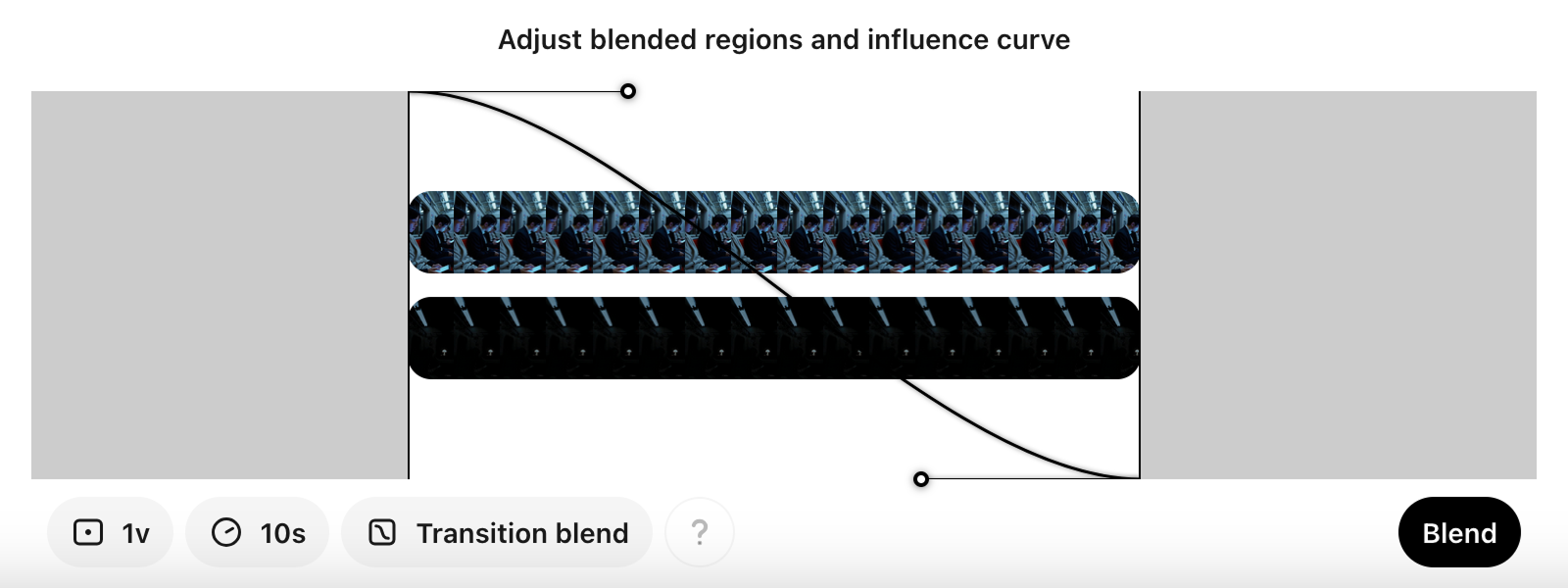
5. Trim and set up: We can trim either video to focus on the sections we want to emphasize in the blend. This allows us to carefully select the portions that contribute to the desired outcome.
6. Generate the blend: After setting up the curve and trimming the videos, we let Sora work its magic and blend the videos together. The result is a unique combination of elements from both videos, seamlessly integrated.
Here’s a side-by-side example where we blend two videos together into a scene:
The blend feature is particularly exciting because it opens up new creative possibilities by merging different visuals into something fresh and innovative.
Style presets
The style presets in Sora allow us to apply predefined artistic styles to our videos, giving them a unique look and feel based on our creative vision.
It includes the following styles:
- Archival: Emulates the look of historical or vintage footage. Typically features muted tones, a slightly worn quality, and may incorporate subtle grain or sepia effects to evoke a sense of age or documentary style.
- Film noir: Inspired by classic black-and-white crime films. Characterized by strong contrasts, dramatic lighting, and deep shadows, giving a moody, cinematic feel.
- Cardboard & papercraft: Mimics the texture and appearance of handcrafted models or dioramas made from paper and cardboard. Has a playful, tactile quality, often with visible edges, layering, and a homemade aesthetic.
- Whimsical stop motion: Suggests a charming, handcrafted animation look (think claymation or other stop-motion styles). Often includes slightly exaggerated or jerky motion effects, warm color palettes, and a childlike, storybook atmosphere.
- Balloon world: Evokes the sense of inflated, soft, balloon-like shapes. Bright, airy, and playful in style, often featuring bold, pastel colors and smooth, rounded contours.
To apply a preset to a prompt, we select it by pressing the preset button at the bottom of the prompt input:

To better visualize these, here’s a montage of five videos generated with each of the styles using the prompt:
“A cinematic, full shot of a bustling New York City street scene, but instead of humans, the pedestrians and workers are stylishly dressed anthropomorphic animals going about their daily routines. The perspective is wide and slightly lower, evoking an immersive sense of everyday life in this imaginative, animal-inhabited metropolis.”
Creating custom presets
While the predefined styles provide a quick and easy way to stylize videos, Sora also allows us to create custom styles. By managing our presets, we can describe specific attributes like lighting, colors, and even upload reference images or videos. This flexibility helps tailor the style to our preferences and the specific mood we aim to achieve.
To create a custom preset, we click the “Manage” option in the preset selection panel:
Then, we click the + button:
A preset consists of a name and a prompt. The prompt should describe the style, type of camera, image quality, and other features we want videos generated with the preset to have.
The preset creator also supports uploading an image with the style we want instead of a text prompt.
Presets make it possible to avoid having to repeat ourselves and save time when we want to create multiple videos with the same style.
Storyboard
Sora storyboards are intended to help us create more complex scenes by describing what happens and when. In this example, we use a storyboard to create a video of a bird in the water and make sure that it drinks water at a specific moment:

We can think of the prompts in a storyboard as keyframes.
The above storyboard uses two prompts to guide the video generation. The first sets the scene while, the second one, sets an action we want to happen. Sora will then try to generate a video by adhering to these prompts at the timestamps they occur.
In my experience, the storyboard feature in Sora falls short of my expectations. While it has the potential to be a powerful tool for creating complex videos, it often fails to deliver, especially in more intricate scenarios.
To get better results, I recommend keeping it simple and avoiding adding too many constraints to the video.
Using storyboard to animate images
The storyboard feature also works using keyframe images instead of textual prompts. In this case, Sora generates a video linking these still images.
Let’s animate a bird flying to a tree and then flying away by creating a storyboard with three keyframes:
- The branch without the bird.
- The branch with the bird on it.
- Again the branch without the bird.
Here are the images that I used:
The bird image was taken from Unsplash, while the image without the bird was generated by removing the bird using AI.
This is the resulting video Sora generated:
Prompting Tips
The basic structure of a prompt
If you don’t know where to begin, use this basic structure for your prompt:
- Subject: Specify the main focus or characters of the video.
- Action or event: State what you want to see happening.
- Setting or environment: Detail the background, including any notable features or styles.
- Style preferences: Mention if you have a style preference (e.g., cinematic, 3D animation).
Use adjectives and descriptive language
Use adjectives liberally to set the tone, mood, and atmosphere. Describe visual and sensory details vividly to enhance the richness of the output.
Example:
"A sleek black cat deftly riding a skateboard down a snowy hill, surrounded by a serene winter landscape."
Incorporate movement and action
Mention camera movements or perspectives (e.g., "FPV shot," "panoramic view"). Specify dynamic actions or subtle nuances to make the video come alive.
Example:
"The camera follows an eagle soaring through a canyon, majestically gliding over crystal-clear waters."
Breaking down complex scenes
Separate complex scenes into smaller actions and combine the video using an external video editor.
Sora doesn’t do very well with multiple actions on the same video so it’s better to generate two separate videos and later combine them.
Example:
Shot 1: "A knight approaches a dragon."
Shot 2: "The dragon breathes fire."
Iterate
Don’t expect perfection with the first prompt. See what works and what doesn’t and adjust accordingly. Remember to use tools like re-cut and remix to keep the good parts and discard the rest.
Conclusion
When I first heard of Sora, I thought I would be able to bring some video ideas to life simply by describing what I imagined. However, in its current state, we’re still quite far from that. More often than not, the generated video doesn’t look at all what I want it to be.
That being said, Sora remains a promising tool for both amateur and professional video makers.
